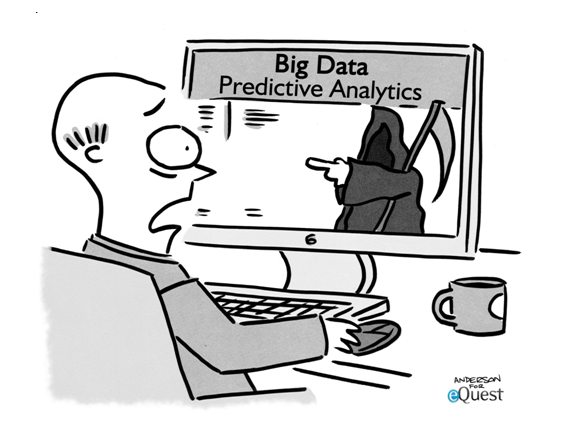There’s hardly an article, news story, webinar, or whitepaper these days that talks about Big Data that doesn’t also talk about predictive analytics. In fact, I contribute extensively to that body of work through my own talks and writings.
So, why is there such hype and curiosity about these topics? Even though the topics may seem complicated, the answer is actually very straightforward. Previously, I reminded you that being surprised is rarely a good thing in business. I emphasized the increase in accuracy in what can now be achieved in the business models and forecasts using Big Data. Predictive analytics is the methodology that makes that last statement true. Predictive analytics takes “historical” data into consideration – using data mining and statistics – to try to predict what will happen in the future. Now enter the concept of Big Data. Predictive analytics techniques performed on the vast stores of very recently collected “historical” data creates the opportunity to develop those more accurate models and forecasts in a near-real-time mode. In essence, the timeframe of the “historical data” being analyzed has now changed. Companies now have the ability to make business decisions based on these real-time forecasts. This is why there is such hype and interest: who wants to drive looking out of their rear view mirror?
Predictive analytics though does not provide guarantees. Instead, it is all about increasing the likelihood that a desired outcome will occur – at the right time, the first time. These concepts of increased likelihood and timeliness are what make applying it to decision making so enticing. Imagine if you were given the insights that would increase your accuracy of knowing the outcome of a coin toss by 25%. That is a substantial accuracy increase. Suddenly, you would be right 62.5% of the time. The other side of that coin, though, is that unfortunately you would still be incorrect 37.5% of the time. It is important to understand and keep in consideration both of these points. Making faster, educated decisions, and taking quicker action should be at the heart of every business strategy.
Big Data derived predictive analytics are now popping up all around us in the consumer and social world we interact in. Cash registers are now available that predict which discounts will be redeemed to make smarter decisions as to what coupons will be given at check-out to drive sales. Websites are now predicting which ad you’ll click in order to instantly choose which ad to show, driving millions in new-found revenue. Netflix uses this approach to predict which movies you will like. Doctors are now leveraging this to predict which treatment options are best to pursue. Online dating sites predict who will be your best mate. Even decisions about who should be eligible for parole are starting to be used forecast the risk that a convict will offend again. Everywhere we turn, the power of Big Data derived predictions is becoming evident.
Those of us who lead companies and run its operations are also poised to benefit from this great power. While I don’t have a crystal ball (little predictive modeling humor there), I am very excited about the possibilities of predictive modeling being applied to the business world. In fact, eQuest is also on the forefront of building systems that leverage the power of predictive analytics for our customer’s advantage. With our announcement of our Post-Scheduler feature, we are now giving our customer’s an industry first capability – the ability to know which days of week to initiate an advertising campaign that will increase the likelihood of generating the highest candidate response rate. By running predictive analyses against our Big Data, we extract the connections and correlations in the data and provide those insights directly to the customer directly at the point of the transaction. More importantly, though, we are providing this at time when they need to achieve a critical business outcome – the first time.
We have also taken this concept of providing predictive analytic insights one step further to help them develop their talent acquisition sourcing strategies. Companies have to both find and attract the best talent in order to achieve the innovation and competitive advantage required to remain a viable business. Our Big Data for HR consulting service provides customers with the guidance on where to place their online recruitment advertising for optimal performance and cost. It is now well understood that the talent acquisition function has the highest business impact of any of the HR functions on the success of running a business. A data-driven talent acquisition team can drive lasting competitive advantage for their businesses by ensuring that its talent acquisition activities are strategically aligned to support two critical business success measures – revenue growth and profitability. eQuest is providing our customers tailored, Big Data, predictive analytics derived forecasts that drive their ability to build optimal online recruitment marketing campaigns – the first time.
Have you benefitted from predictive analytics? I’d welcome your stories and feedback. Send them along to david.bernstein@equest.com.
Want to learn how to experience the power of Big Data-derived predictive analytics? Click here to make sense of what Big Data for HR really means. Learn more about how eQuest’s Big Data Predictive Analytics services are transforming the talent acquisition process for companies of all sizes across the globe.

